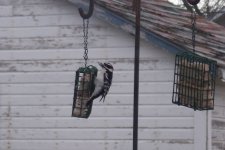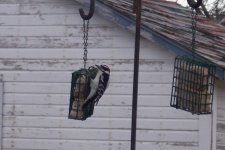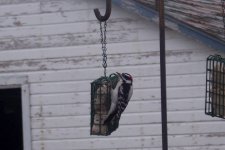Every male Downy has a single red patch. A male Hairy, on the other hand, has the red patch divided into two sections by the black stripe on the head (a vertical stripe dividing the head into two sides: left and right). According to a source, of the surveyed Downy and Hairy populations east of the Rockies, only the Hairies had this divided patch. However, not many field guides mention this patch characteristic as it may be difficult to see in the field. I noticed this stripe back in 2004. I think if you search the forums, you could find a thread with the picture of the comparision of the patches that I made from my pictures.
Identifying females is a bit trickier as they don't have the red patch. As I have not seen a female Hairy around my house, I don't know how to tell them apart with the greatest of ease. Best bet would be to use a combination of field marks (beak size relative to head, tail spots, etc.) and make your ID that way. If you get lots of each species, photographs could help you determine if there are any other features that only downies would have or hairies would have. Like I said, the black stripe on male hairies is not mentioned in most field guides, so use that to your liking (I guarantee you, if you see it from behind first, check for this patch and make your ID. If the bird turns around and it has the bigger bill, then you were right on the mark with Hairy)
Other guides note that on Hairies west of the Rockies, they tend to have tail spots, which is why I try not to base my ID solely on the tail spots alone. Even based on bird size alone is not recommended, as a male downy is nearly as big as a female hairy.
Hope this information overload helps you out some.







